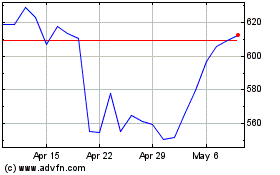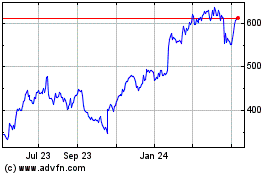By Tim Mullaney
What would you call it if you gave a party and just about
everybody came?
Maybe, the Tech Rally of 2019.
After a tough 2018 when riskier or "high beta" stocks got nailed
in the fourth quarter, tech has had a revival this year that is
startling in both its magnitude and its breadth. The average
tech-stock fund tracked by Morningstar was up 22% for the year at
the middle of last week, compared with a 16% climb in the S&P
500. Only seven tech funds in Morningstar's database were trailing
the broad market, but the mean actively managed tech fund was still
5.6 percentage points behind the surge in the S&P 500
Information Tech subindex.
"Information technology was the S&P 500's best-performing
sector during the first half of 2019," Morningstar analyst Robby
Greenhold says. "The sector's gain accounted for almost a third of
the S&P 500's rise."
The most distinctive thing about tech funds so far this year is
how difficult it has been to do badly. Only one fund is in the red,
the $8.2 million Upright Growth fund (UPUPX), and four funds
tracked by Morningstar are up more than 30%. The only funds doing
better are those -- notably gold funds and more recently long-dated
bond and real-estate funds -- which play on the uncertainty that
President Trump's market-moving outbursts brought this summer.
All sorts of different tech-investing strategies are working.
What follows is a look at the portfolios of some of the top
performers.
No. 1 this year is Fidelity Select IT Services fund (FBSOX), up
37%. The $4 billion fund has little of the dot-com flash associated
with the FAANG stocks ( Facebook, Apple, Amazon.com, Netflix and
Google parent Alphabet). The big idea at Select IT Services right
now is payments -- companies that automate or digitize the movement
of money, either from consumers to stores or between institutions.
Most of the fund's investments are in familiar names from before
the days when tech dominated the stock market.
Payments plays
The top four holdings as of June 30 were all payments plays, and
accounted for 43% of the FBSOX portfolio: Visa, Mastercard, PayPal
and Worldpay Inc., which was acquired by Fidelity National
Information Services in July.
"The global migration from cash to electronic payment methods
has continued, creating a rising-tide environment for a number of
payment-related companies," fund co-manager Zach Turner says.
"There has also been significant consolidation."
The top five contributors to the fund's gain, Mr. Turner says,
have all been payments-related stocks such as Visa, Mastercard,
PayPal and First Data Corp. The fund added to its positions in Visa
and Mastercard in the second quarter. After Worldpay and First Data
were acquired the fund added to its positions in the acquirers,
Fidelity National Information Services and Fiserv.
Right behind the Fidelity fund are mutual funds still working
the consumer-internet themes powered by the FAANGs. BlackRock
Technology Opportunities fund (BGSAX), for example, was up 31% as
of last week with a portfolio that has Chinese internet leaders
Tencent and Alibaba as well as Alphabet and Amazon in its top five
holdings. Facebook and Apple are in the top 10.
Another top tech fund is Firsthand Alternative Energy (ALTEX),
considered a tech fund by many because semiconductors are so
important to solar power and power-grid management. This fund's top
two holdings are chip-related companies, Power Integrations (up
more than 40% this year as of last week) and Cree. But Firsthand
has had a weaker track record than most of its top peers, and
Morningstar rates the fund one star out of five.
A common element among many of the top actively managed tech
funds -- except Firsthand -- is a large holding in Microsoft, whose
cloud computing business has driven its stock up more than 30% this
year, Morningstar's Mr. Greengold says. Putnam Global Technology
(PGTAX) has 19% of its holdings in Microsoft.
Passively managed tech funds have seen even bigger returns than
their actively managed brethren.
Exchange-traded funds focused on U.S. tech stocks were up an
average of 21.8% for the year as of Aug. 21, says Stacey Brorup, a
research assistant at ETF.com. Chip and software stocks helped lead
the way. Chip returns were nearly double those of U.S. internet
companies for the same period.
The top-performing tech ETF so far this year, with a gain of
roughly 50%, is Invesco DWA Technology Momentum ETF (PTF), whose
strategy is to make concentrated bets on 30 or more companies that
have recently been near the top of the tech-heavy Nasdaq index. Its
biggest holding, Enphase Energy, which makes equipment to convert
solar power to alternating current from direct current, has doubled
since early May.
The tech disconnect
It's not certain how much longer the tech rally can run, ETF.com
chief executive Dave Nadig says.
"The next 12 months will largely be about the disconnect between
tech and the rest of the market," says Mr. Nadig, who argues that
so far tech has been less exposed to trade tensions than other
stocks. "This can't last forever, and with the additional tariffs
coming on, I think we're set up for a rough patch. That's part of
why we see so much volatility in the sector."
CFRA Research strategist Sam Stovall is still relatively bullish
on tech stocks, which the New York-based firm rates "overweight,"
but is watching the sector and wondering how long this rally can
last. That said, tech stocks' 12% valuation premium to the rest of
the market is equal to its median for the past 21 years, he
adds.
"We have an 'overweight' ranking on tech and are wondering about
the same thing," Mr. Stovall says. "The chart shows tech remaining
strong versus the S&P 500, but the strength has waned over the
past year."
Mr. Mullaney is a writer in Maplewood, N.J. He can be reached at
reports@wsj.com.
(END) Dow Jones Newswires
September 08, 2019 22:22 ET (02:22 GMT)
Copyright (c) 2019 Dow Jones & Company, Inc.
Netflix (NASDAQ:NFLX)
Historical Stock Chart
From Mar 2024 to Apr 2024

Netflix (NASDAQ:NFLX)
Historical Stock Chart
From Apr 2023 to Apr 2024
